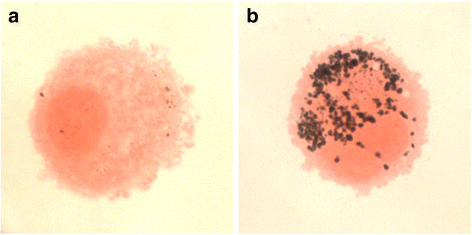Household air pollution and the lung microbiome of healthy adults in Malawi: a cross-sectional study
- PMID: 27514621
- PMCID: PMC4982214
- DOI: 10.1186/s12866-016-0803-7
Household air pollution and the lung microbiome of healthy adults in Malawi: a cross-sectional study
Abstract
Background: Domestic combustion of biomass fuels, such as wood, charcoal, crop residue and dung causes Household Air Pollution (HAP). These inhaled particulates affect more than half of the world's population, causing respiratory problems such as infection and inflammatory lung disease. We examined whether the presence of black carbon in alveolar macrophages was associated with alterations in the lung microbiome in a Malawi population.
Methods: Bronchoalveolar lavage samples from 44 healthy adults were sequenced using 16S rDNA amplification to assess microbial diversity, richness and relative taxa abundance. Individuals were classified as high or low particulate exposure as determined by questionnaire and the percentage of black carbon within their alveolar macrophages.
Results: Subjects in the low and high particulate groups did not differ in terms of source of fuels used for cooking or lighting. There was no difference in alpha or beta diversity by particulate group. Neisseria and Streptococcus were significantly more abundant in samples from high particulate exposed individuals, and Tropheryma was found less abundant. Petrobacter abundance was higher in people using biomass fuel for household cooking and lighting, compared with exclusive use of electricity.
Conclusions: Healthy adults in Malawi exposed to higher levels of particulates have higher abundances of potentially pathogenic bacteria (Streptococcus, Neisseria) within their lung microbiome. Domestic biomass fuel use was associated with an uncommon environmental bacterium (Petrobacter) associated with oil-rich niches.
Keywords: Alveolar macrophage; Household air pollution; Petrobacter; Respiratory microbiome.
Figures
Similar articles
-
A cross-sectional study of household biomass fuel use among a periurban population in Malawi.Ann Am Thorac Soc. 2014 Jul;11(6):915-24. doi: 10.1513/AnnalsATS.201311-413OC. Ann Am Thorac Soc. 2014. PMID: 24960156 Free PMC article.
-
Domestic smoke exposure is associated with alveolar macrophage particulate load.Trop Med Int Health. 2009 Mar;14(3):349-54. doi: 10.1111/j.1365-3156.2009.02230.x. Trop Med Int Health. 2009. PMID: 19278528
-
Household air pollution causes dose-dependent inflammation and altered phagocytosis in human macrophages.Am J Respir Cell Mol Biol. 2015 May;52(5):584-93. doi: 10.1165/rcmb.2014-0188OC. Am J Respir Cell Mol Biol. 2015. PMID: 25254931 Free PMC article.
-
Respiratory risks from household air pollution in low and middle income countries.Lancet Respir Med. 2014 Oct;2(10):823-60. doi: 10.1016/S2213-2600(14)70168-7. Epub 2014 Sep 2. Lancet Respir Med. 2014. PMID: 25193349 Free PMC article. Review.
-
Household air pollution from domestic combustion of solid fuels and health.J Allergy Clin Immunol. 2019 Jun;143(6):1979-1987. doi: 10.1016/j.jaci.2019.04.016. J Allergy Clin Immunol. 2019. PMID: 31176380 Review.
Cited by
-
Microbiota dysbiosis in lung cancer: evidence of association and potential mechanisms.Transl Lung Cancer Res. 2020 Aug;9(4):1554-1568. doi: 10.21037/tlcr-20-156. Transl Lung Cancer Res. 2020. PMID: 32953527 Free PMC article. Review.
-
Evidence Supporting a Phased Immuno-physiological Approach to COVID-19 From Prevention Through Recovery.Integr Med (Encinitas). 2020;19(Suppl 1):8-35. Integr Med (Encinitas). 2020. PMID: 32425712 Free PMC article. Review.
-
Inno4Vac Workshop Report Part 2: RSV-Controlled Human Infection Model (CHIM) Strain Selection and Immune Assays for RSV CHIM Studies, November 2021, MHRA, UK.Influenza Other Respir Viruses. 2024 Oct;18(10):e70013. doi: 10.1111/irv.70013. Influenza Other Respir Viruses. 2024. PMID: 39440808 Free PMC article. Review.
-
Air pollution induces Staphylococcus aureus USA300 respiratory tract colonization mediated by specific bacterial genetic responses involving the global virulence gene regulators Agr and Sae.Environ Microbiol. 2022 Sep;24(9):4449-4465. doi: 10.1111/1462-2920.16076. Epub 2022 Jun 1. Environ Microbiol. 2022. PMID: 35642645 Free PMC article.
-
Immunosenescence, Inflammaging, and Lung Senescence in Asthma in the Elderly.Biomolecules. 2022 Oct 11;12(10):1456. doi: 10.3390/biom12101456. Biomolecules. 2022. PMID: 36291665 Free PMC article. Review.
References
Publication types
MeSH terms
Substances
Grants and funding
LinkOut - more resources
Full Text Sources
Other Literature Sources
Medical


